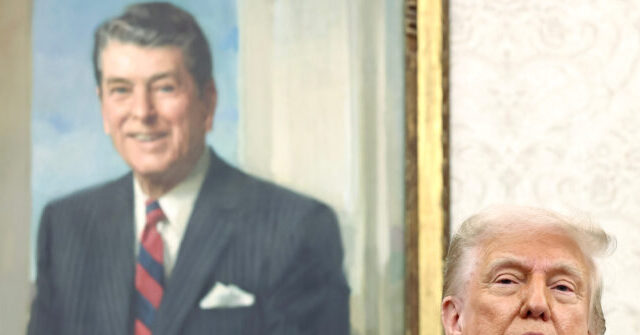Claim: Trump says Ronald Reagan “loved tariffs for our country and its national security,” pushing back on a Canadian ad that stitched together Reagan’s 1987 anti-protectionism lines.
Verdict: Mostly True. Reagan imposed extensive tariffs despite free-trade rhetoric, though “loved” may exaggerate his enthusiasm. His actions were often protectionist while his language rarely was.
The controversy began when Ontario released an ad intended to air on U.S. television featuring Ronald Reagan’s voice warning against protectionism—a speech he delivered the same week he imposed tariffs on Japanese semiconductors. The ad used excerpts from Reagan’s April 1987 radio address declaring that “trade barriers hurt every American worker and consumer” and that “markets shrink and collapse” when countries turn protectionist. The clips were genuine but rearranged, omitting that Reagan had delivered the remarks in connection with ordering new duties on Japan.
Trump denounced the ad as “fraudulent,” suspended trade talks with Canada, and announced an additional 10 percent tariff on Canadian goods. The Reagan Foundation also pushed back, saying the ad “misrepresents President Reagan’s lifelong commitment to free and fair trade.”
The New York Times, Associated Press, and PBS’s PolitiFact all rushed out fact-checks defending Reagan’s free-trade legacy. They noted that the ad “faithfully reproduced” Reagan’s words but argued Trump was wrong to claim Reagan favored tariffs, pointing to his references to Smoot–Hawley and his praise of open markets. Yet those same outlets conceded the context: Reagan’s speech followed new semiconductor duties, which he called a “special case.”
That “special case” was hardly unique. Reagan’s presidency was defined by free-trade rhetoric and managed-trade practice. Even in his own day, the gap was obvious. In 1988, the libertarian Cato Institute published “The Reagan Record on Trade: Rhetoric vs. Reality” by Sheldon L. Richman. It opened by noting how Reagan’s tariffs on Japanese electronics were portrayed as the reluctant act of a “long-forbearing president whose patience was exhausted.” The press, Richman wrote, “reminded the public that such restraints were imposed by a staunch free trader,” implying that if he resorted to tariffs, Japan must truly be at fault.
Richman dismissed that myth outright. “Calling oneself a free trader is not the same thing as being a free trader,” he wrote. “Only short memories and a refusal to believe one’s own eyes would account for the view that President Reagan is a free trader.” His conclusion was blunt: “By this standard, the Reagan administration has failed to promote free trade. Ronald Reagan by his actions has become the most protectionist president since Herbert Hoover, the heavyweight champion of protectionists.”
Contemporary coverage in the New York Times echoed the same view, describing Reagan’s “voluntary” steel and auto restraints as “the most protectionist action this administration has yet taken.” And the record supports that. Reagan imposed import limits on Japanese cars, created global quotas for steel, tightened textile restrictions, maintained sugar quotas, and levied a 1,000-percent tariff on Japanese motorcycles to save Harley-Davidson. He pressured Japanese automakers to open factories in the American Midwest and South, slapped duties on semiconductors, Canadian lumber, and machine tools, and oversaw a surge in petitions for protection from U.S. industries.
By 1987, his administration was drafting a legislative package to “ease the trade gap,” combining export subsidies, expanded anti-dumping powers, and new penalties for counterfeit imports—so overtly protectionist that aides urged him not to call it a trade bill at all.
Reagan’s critics, including Rep. Dick Durbin, accused him of winking at Congress while preaching free trade. His defenders called it pragmatism: a way to stabilize industries and extract foreign concessions. Either way, Reagan used tariffs and quotas as deliberate instruments of state power, not ideological taboos.
Does Trump go further than Reagan did? Yes. But that’s because he faces trade deficits and unfair-trade practices that dwarf anything imagined in Reagan’s time. The imbalances and barriers that looked anomalous and transitory in Reagan’s era—hiccups on the way to global free trade—have hardened into a beggar-thy-American-neighbor system.
When Reagan gave his 1987 radio address, the United States was running a record $153 billion trade deficit, up from just $25 billion seven years earlier—about $447 billion in today’s dollars. It was the largest peacetime gap in modern U.S. history to that point. But the problem, as Reagan saw it, was concentrated. Nearly all of it came from a few countries—Japan, West Germany, Canada, and newly industrializing economies like Taiwan and South Korea. Reagan’s protectionism targeted these “special cases,” combining diplomatic pressure with selective tariffs and “voluntary” quotas.
Four decades later, the exception has become the rule. In 2024, the U.S. trade deficit reached $773 billion and is far more pervasive. America now runs deficits with nearly every major trading partner: China (–$281B), the European Union (–$190B), Mexico (–$152B), Canada (–$81B), with significant gaps against Japan, South Korea, Vietnam, and India.
What Reagan treated as discrete distortions—Japanese industrial policy, German currency strategy, Korean steel dumping—has become a systemic pattern baked into the global trading order.
Reagan’s world still believed in symmetrical globalization—market reforms abroad would gradually erase imbalances. We live in the world where those reforms never arrived. The deficits persisted, production offshored, and barriers to U.S. exports hardened into a global system dependent on permanent U.S. deficits.
That transformation explains the difference in scale between Reagan’s and Trump’s approaches. Reagan could still pretend free trade was the default and tariffs were temporary correctives. Trump faces an economy in which those “special cases” have become the general case. The selective protectionism of the 1980s has become the structural imbalance of the 2020s.
Where Reagan used tariffs to discipline a few offenders, Trump uses them as a universal framework to rebalance a world economy that runs permanently on U.S. deficits. The logic is the same—tariffs as leverage, as tools of negotiation and national defense—but the field of battle has expanded.
Read the full article here
